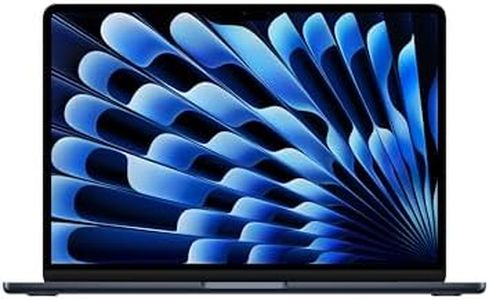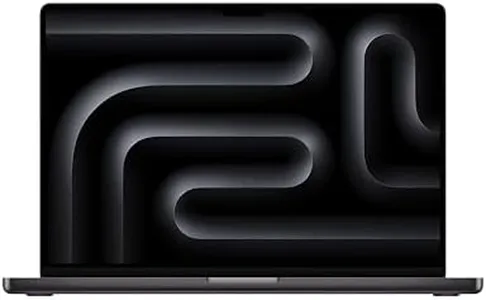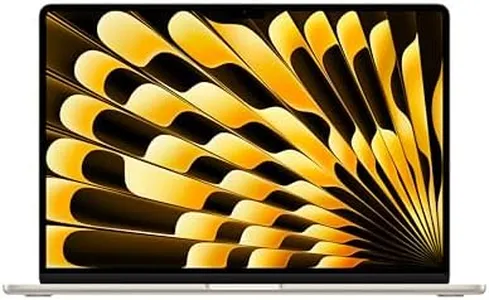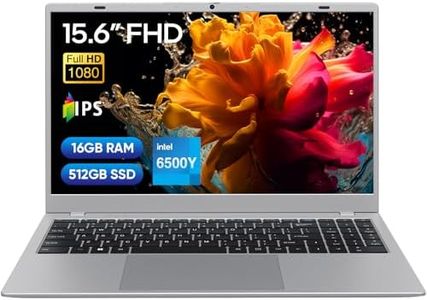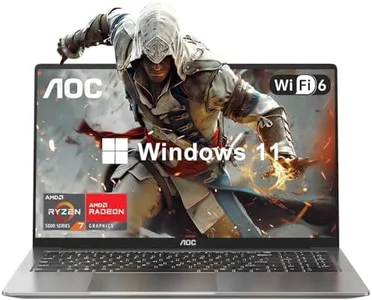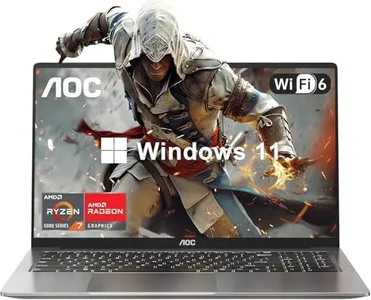10 Best Laptops For Video Editing 2025 in the United States
Our technology thoroughly searches through the online shopping world, reviewing hundreds of sites. We then process and analyze this information, updating in real-time to bring you the latest top-rated products. This way, you always get the best and most current options available.

Our Top Picks
Winner
Apple 2025 MacBook Air 13-inch Laptop with M4 chip: Built for Apple Intelligence, 13.6-inch Liquid Retina Display, 16GB Unified Memory, 512GB SSD Storage, 12MP Center Stage Camera, Touch ID; Midnight
Most important from
4775 reviews
The 2025 Apple MacBook Air with the M4 chip is a strong choice for video editing, especially if you want a lightweight and portable laptop. Its 10-core CPU and 10-core integrated GPU provide smooth performance for editing tasks and handling multiple apps at once, making the editing process faster and more fluid. With 16GB of unified memory, it can manage video files well, though professional editors working with very large projects might eventually need more RAM. The 512GB SSD offers decent storage, but depending on your video file sizes, you might want additional external storage.
The 13.6-inch Liquid Retina display is bright and sharp with support for 1 billion colors, which helps in seeing accurate colors and fine details — a real plus for video work. Battery life is impressive, offering up to 18 hours, so you can edit on the go without constantly searching for a charger. Though it has only two Thunderbolt 4 ports and a headphone jack, these support fast data transfer and connection to up to two external monitors, which is useful for expanding your workspace.
A limitation is the lack of a dedicated graphics card, as the GPU is integrated. While good for most editing tasks, it may struggle with very high-end or 4K video workflows compared to more powerful laptops with discrete GPUs. Also, the screen size is on the smaller side, which might require an external monitor for more comfortable editing sessions. The MacBook Air runs macOS smoothly and works seamlessly with other Apple devices, which can boost productivity if you're already in the Apple ecosystem. This MacBook Air excels for casual to moderately intensive video editing due to its powerful chip, great display, and long battery life, but professionals handling demanding projects might find it limited in GPU power and screen space.
Most important from
4775 reviews
Apple 2025 MacBook Pro Laptop with M5 chip with 10‑core CPU and 10‑core GPU: Built for Apple Intelligence, 14.2-inch Liquid Retina XDR Display, 16GB Unified Memory, 512GB SSD Storage; Silver
Most important from
157 reviews
The 2025 Apple MacBook Pro with the M5 chip is a strong choice for video editing thanks to its powerful 10-core CPU and GPU, which deliver fast performance for demanding tasks. With 16GB of unified memory, it smoothly handles professional editing software like Adobe Creative Cloud and supports advanced AI features, making processes like rendering and effects quicker. The 512GB SSD offers solid storage, but heavier video projects might require additional external drives.
The 14.2-inch Liquid Retina XDR display is excellent for editing, offering bright, vivid colors and sharp details with high contrast, which helps in accurately viewing video footage. Battery life is impressively long, allowing up to 24 hours of video streaming and 16 hours of wireless use, so you can work unplugged for extended sessions. Connectivity is versatile, featuring three Thunderbolt 4 ports, an HDMI port, an SDXC card slot, and a headphone jack, covering most needs for external devices and media cards.
While the integrated GPU is strong for many editing tasks, it might not match the raw power of dedicated graphics cards found in some Windows laptops specially designed for heavy 3D or GPU-intensive editing. Additionally, the 512GB storage could fill up quickly with large video files, so planning for external storage is advisable. The MacBook Pro's seamless integration with other Apple devices and macOS optimizations adds convenience but may feel limiting if you prefer Windows-based software or hardware ecosystems. This MacBook Pro is ideal for video editors seeking a portable, high-quality display and excellent processing power within an Apple-friendly environment, though users with very large projects or specialized GPU needs might want to consider storage upgrades or alternative options.
Most important from
157 reviews
Apple 2024 MacBook Pro Laptop with M4 Max, 16‑core CPU, 40‑core GPU: Built for Apple Intelligence, 16.2-inch Liquid Retina XDR Display, 48GB Unified Memory, 1TB SSD Storage; Space Black
Most important from
566 reviews
The Apple 2024 MacBook Pro with the M4 Max chip is a strong choice for video editing thanks to its powerful 16-core CPU and 40-core GPU, which handle demanding tasks like 3D rendering and large video projects smoothly. Its 48GB of unified memory and fast 1TB SSD allow for quick multitasking and ample storage for large files, though users working with very large libraries might want to consider higher storage options. The 16.2-inch Liquid Retina XDR display offers excellent brightness, color accuracy, and contrast, which is crucial for precise video color grading and editing.
Battery life is impressive, with up to 21 hours of video streaming, so you can work unplugged for long stretches. Connectivity-wise, it includes three Thunderbolt 5 ports, an HDMI port, an SDXC card slot, and a MagSafe charging port, covering most accessory and external display needs without dongles. Some users might find the laptop relatively heavy at nearly 5 pounds and priced at a premium, but its build quality and integration with Apple’s ecosystem can be very attractive if you already use Apple devices.
The lack of discrete GPU options could be a consideration, but the M4 Max’s integrated GPU performs exceptionally well for creative tasks. This MacBook Pro suits professional and demanding video editors who need top-tier performance, a stunning display, and excellent battery life in a portable package.
Most important from
566 reviews
Buying Guide for the Best Laptops For Video Editing
Choosing the right laptop for video editing is crucial because it directly impacts your productivity and the quality of your work. Video editing is a resource-intensive task that requires a powerful machine to handle large files, complex software, and high-resolution videos. When selecting a laptop for video editing, you need to consider several key specifications to ensure that the laptop can meet your needs and provide a smooth editing experience.FAQ
Most Popular Categories Right Now
